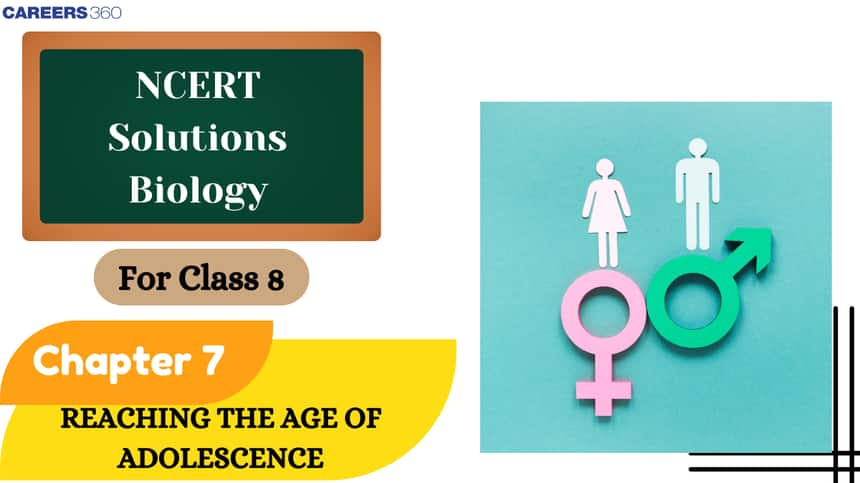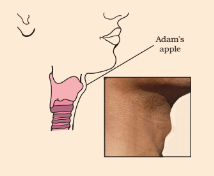Aakash Repeater Courses
ApplyTake Aakash iACST and get instant scholarship on coaching programs.
NCERT Solutions for Class 8 Science Chapter 7 Reaching The Age of Adolescence discusses the physical, emotional, and hormonal development during adolescence. The chapter includes major subjects such as puberty, reproductive health, secondary sex characteristics, and how hormones help in growth and development.

Adolescents are taught about the endocrine system, menstrual cycle, hygiene, and dietary needs in adolescence. The chapter also focuses on living a healthy lifestyle and understanding changes in the human body. NCERT Solutions for Class 8 Science offer concise, step-by-step solutions to textbook questions in a well-organized and easy-to-understand way, making it simpler for students to grasp puberty, hormonal control, and health during adolescence.
Students can download the complete questions with detailed answers in a PDF of this chapter for better learning:
Find clear and step-by-step solutions to all the exercises and in-text questions from this chapter below to help you understand the concepts better and score well in exams.
Answer:
Hormones are chemical messengers produced by endocrine glands to control different body changes. The endocrine system's secretions have a key role in governing growth, development, and other body functions in humans.
Question 2. Define adolescence
Answer:
Question 3. What is menstruation? Explain
Answer:
In women, the ova mature at puberty (about 10 to 12 years of age). One ovum matures every 28-30 days and is released from the ovaries. At the same time, the lining of the uterus gets thickened to accommodate a potential pregnancy. In case fertilization does not happen, the thickened uterine lining and blood vessels are shed from the body along with the unfertilized egg, leading to bleeding. Menstruation is referred to as such a process.
Question 4. List changes in the body that take place at puberty.
Answer: Changes That Occur During Puberty:
Increase in body height and weight.
In males, the chest and shoulders widen, while in females, the region below the waist becomes broader.
The voice box (larynx) enlarges in males, forming the Adam’s apple, while in females, it remains smaller.
Males develop a deep voice, whereas females have a high-pitched voice.
Secondary sexual characteristics develop, including underarm hair, facial hair (beard), and body hair in both genders.
The male and female reproductive organs become fully functional.
In males, the testes start producing sperm.
In females, the ovaries enlarge, eggs mature, and menstruation begins.
Question 5. Prepare a Table having two columns depicting names of endocrine glands and hormones secreted by them.
Answer:
ENDOCRINE GLANDS
| HORMONES
|
Question 6. What are sex hormones? Why are they named so? State their function.
Answer:
Sex hormones are chemical substances secreted by the male and female sex organs. For instance, testosterone is a male sex hormone secreted by the testes, while estrogen is the female sex hormone secreted by the ovaries.
They are secreted by the sex organs and affect the growth of sexual features, hence being referred to as sex hormones.
Functions of Sex Hormones:
Estrogen (Female Hormone): It is responsible for the formation of breasts (mammary glands), which secrete milk to newborns. It also helps in the growth and development of female reproductive organs.
Testosterone (Male Hormone): It is responsible for the development of secondary sexual features like beard, body hair, and male reproductive organ development.
Question 7. Choose the correct option.
(a) Adolescents should be careful about what they eat, because
(i) A proper diet develops their brains.
(ii) A proper diet is needed for the rapid growth taking place in their body.
(iii) Adolescents feel hungry all the time.
(iv) Taste buds are well developed in teenagers.
Answer:
Adolescents should be careful about what they eat because (ii) proper diet is needed for the rapid growth taking place in their bodies.
Question 7. Choose the correct option
(b) The reproductive age in women starts when their
(i) menstruation starts.
(ii) Breasts start developing.
(iii) body weight increases.
(iv) height increases.
Answer:
(b) The reproductive age in women starts when their menstruation starts.
Menstruation is the initiation of the reproductive stage in the female.
Question 7. Choose the correct option.
(c) The right meal for adolescents consists of
(i) chips, noodles, coke.
(ii) chapati, dal, vegetables .
(iii) rice, noodles and burgers.
(iv) vegetable cutlets, chips and lemon drink.
Answer:
(c) The right meal for adolescents consists of (ii) chapati, dal, and vegetables.
Adolescents should consume a properly balanced diet to compensate for the rapid growth taking place in them.
Question 8. Write notes on:
(a) Adam's apple
Answer:
Adam's apple-
At the age of puberty, the voice box or the larynx of humans begins to grow. In the case of boys, it develops larger voice boxes. The developing voice box in boys can be seen as a protruding part of the throat. This protruding part in boys is called the Adam’s apple. In girls, the larynx is small in size so that it can barely be visible from outside.

Question 8. Write notes on-
(b) Secondary sexual characters
Answer:
Secondary sexual characters-
Secondary sexual features are those which distinguish males from females, mainly appearing at puberty.
For boys, these include the development of a beard and mustache, the appearance of hair on the chest, and hair development in the pubic area and elsewhere.
For girls, secondary sexual features are an enlargement of the breasts, as well as genital hair development and other body hair.
Question 8. Write notes on-
(c) Sex determination in the unborn baby.
Answer:
Sex determination of baby-
Every human being has 46 chromosomes with 23 pairs. Of these, two chromosomes, X & Y, are the sex chromosomes. A woman has two X chromosomes, and a man has one X and one Y chromosome. The female gamete ovum and male gamete sperm have only one set of chromosomes. The unfertilized egg always contains one X chromosome, but sperms may contain two types of chromosomes. They may contain either an X chromosome or a Y chromosome. When the sperm of the X chromosome of the male fertilizes the egg (X chromosome), the zygote would contain two X chromosomes and become a female child. But if the sperm has a Y chromosome and inseminates with the egg (X chromosomes), the zygote would form a male child (XY). Therefore, it is apparent that the gender of an unborn child is established by the sex chromosomes of the father.
Question 9. Word game: Use the clues to work out the words.
Across
3. Protruding voice box in boys
4. Glands without ducts
7. Endocrine gland attached to brain
8. Secretion of endocrine glands
9. Pancreatic hormone
10. Female hormone
Down
1. Male hormone
2. Secretes thyroxine
3. Another term for teenage
5. Hormone reaches here through blood stream
6. Voice box
7. Terms for changes at adolescence

Answer:

Answer:
The graph shows how height and age are related between girls and boys during puberty. At first (ages 4-8), girls are smaller than boys. Girls, though, experience a very fast increase in height when they are 12-16 years old, before their heights settle. The boys, meanwhile, have an acute rise in height at about age 16.
Also Check NCERT Books and NCERT Syllabus here:
This chapter is about the physical and hormonal changes that occur during puberty, resulting in reproductive maturity. It covers subjects such as growth spurts, secondary sexual characteristics, regulation by hormones, menstruation in females, and reproductive health. The work done by testosterone and estrogen is also discussed in Class 8 Science Chapter 7, Reaching the Age of Adolescence, as well as the need to keep oneself clean during adolescence. NCERT Solutions for this chapter are well-explained, making it easier for students to comprehend these biological changes in a simple and systematic way.
The key topics covered in this chapter are:
7 | Reaching The Age of Adolescence |
| 7.1 | Adolescence and Puberty |
| 7.2 | Changes at Puberty |
| 7.3 | Secondary Sexual Characters |
| 7.4 | Role of Hormones in Initiating Reproductive Function |
| 7.5 | Reproductive Phase of Life in Humans |
| 7.6 | How is the Sex of the Baby Determined? |
| 7.7 | Hormones other than Sex Hormones |
| 7.8 | Role of Hormones in Completing the Life History of Insects and Frogs |
| 7.9 | Reproductive Health |
These questions are designed to test your understanding of key concepts from the chapter and help strengthen your preparation through regular practice.
Question 1:
Puberty age in females is:
A) 10 to 12
B) 12 to 14
C) A to 10
D) More than 14 years
Answer:
The correct answer is option(a), 10 to 12 years.
Question 2:
Which hormones help in the development of secondary sexual characters?
Answer:
The hormones that help in the development of secondary sexual characters are :
In males- Testosterone
In females- Estrogen
Question 3:
Define puberty?
Answer:
The process of maturation of boys and girls is called puberty. During this time, boys and girls acquire a more adult like body which is physically capable of sexual reproduction. This process triggers the breasts in girls to develop while boys experience changes to their voice. This developmental transformation occurs due to the hormones released by the ovaries or testes and brain.
Question 4:
What is pituitary gland? Name the hormones secreted by it?
Answer:
The pituitary is a pea-sized gland located at the base of the brain. It is refereed to as the “master gland” as it controls other endocrine glands.
The hormones secreted by Pituitary Gland are given below:
Question 5:
Write a short note on AIDS.
Answer:
AIDS (Acquired Immunodeficiency syndrome) is a dangerous disease that first appeared as the result of a virus known as HIV (Human immunodeficiency virus). HIV attacks the human body's natural immune system which protects one from infections. When the immune system weakens so much that it makes the body unable to fight even the less harmful microorganism, the condition is termed as AIDS. AIDS cannot be contracted by touching or hugging or sharing meals.
Ways through which AIDS spreads:
Question 6:
Why should adolescents have a balanced diet?
Answer:
Growing and developing are the unique qualities of a life stage known as adolescence. The transformation of the body, hormonal, and emotional occur in this stage. To make such changes possible, it is important to provide the body with all the basic building blocks such as carbohydrates, proteins, fats, and vitamins.
Reasons why a balanced diet is useful:
1. Best substance for bones, muscles tissues to grow rapidly and strongly.
2. A balanced diet makes the immune system strong, allowing the body to fight against infectious diseases.
3. A balanced diet prevents malnutrition and obesity by keeping the body fit and healthy.
4. A balanced diet also helps in improving concentration, memory, and mood, which are important during the growing years.
Below mentioned are the Chapter-wise solutions:
In summary, Chapter 7, Reaching the Age of Adolescenc,e provides useful information regarding the physical, emotional, and hormonal changes experienced during puberty, setting up students to comprehend the changes of adolescence. NCERT Solutions are essential in solidifying these concepts through clear, step-by-step responses to textbook questions, simplifying complex biological processes. These solutions assist learners in establishing a solid foundation for understanding human reproductive health and development so that they are adequately equipped to take their exams and also apply this in real life.
NCERT Solutions For Class 8th: Subject-Wise
Adolescence is the transitional stage between childhood and adulthood, typically from ages 10 to 19. It involves significant physical, emotional, and psychological changes due to hormonal shifts, leading to puberty, growth spurts, and the development of social and cognitive abilities.
Puberty induces physical transformations like fast growth, development of sex organs, growth of body hairs, voice deepening, and heightened distribution of muscles or fat. Puberty also influences emotions and behavior as a result of hormonal changes, readying the body for adulthood.
Secondary sexual characteristics refer to physical traits that emerge at puberty but have no direct part in reproduction. In boys, these consist of a deeper voice and facial hair, whereas breast growth and increased hips are changes seen in girls.
Hormones also control development, metabolism, and sexual development during adolescence. Estrogen and testosterone cause body changes such as deepening of the voice, development of muscles, and menstruation. Other hormones, such as growth hormone and insulin, aid in overall growth.
At puberty, testosterone makes the larynx (voice box) increase in size and the vocal cords get longer and thicker. This makes the voice deeper, and usually, there are temporary voice cracks as the body gets used to it.
The pituitary gland secretes hormones such as luteinizing hormone (LH) and follicle-stimulating hormone (FSH), which stimulate the testes in males and ovaries in females. These hormones cause changes associated with puberty, such as growth spurts and the development of reproductive organs.
Sex hormones such as testosterone and estrogen drive the growth and development of reproductive organs. In males, testosterone supports the production of sperm, whereas in females, estrogen stimulates ovulation and regulation of the menstrual cycle, getting the body ready to reproduce.
Girls start menstruation because of the hormonal fluctuations that govern the reproductive process. Progesterone and estrogen cause the uterine lining to grow, and since there is no fertilization, it comes off as menstrual blood, indicating the beginning of fertility.
The menstrual cycle gets the female body ready for pregnancy by controlling ovulation and the lining of the uterus. A normal cycle is a sign of normal reproductive health, hormonal balance, and general well-being, and it plays an important role in reproduction and fertility.
Nutrition helps supply vitamins, minerals, and proteins essential for quick growth during adolescence. A balanced diet helps in the development of bones, muscles, and brain functions, while deficiency results in stunted growth and diseases.

Take Aakash iACST and get instant scholarship on coaching programs.

This ebook serves as a valuable study guide for NEET 2025 exam.

This e-book offers NEET PYQ and serves as an indispensable NEET study material.

As per latest syllabus. Physics formulas, equations, & laws of class 11 & 12th chapters
As per latest syllabus. Chemistry formulas, equations, & laws of class 11 & 12th chapters
As per latest 2024 syllabus. Study 40% syllabus and score upto 100% marks in JEE